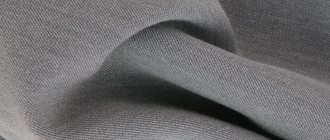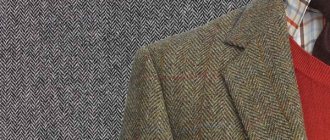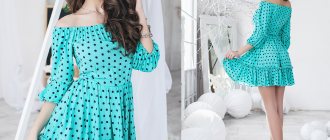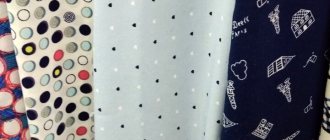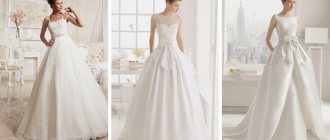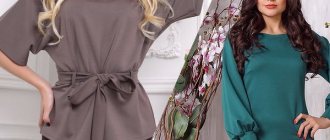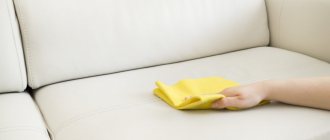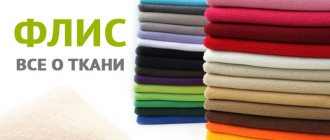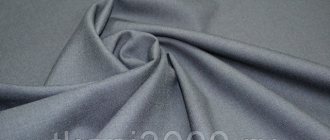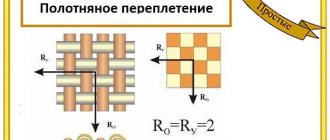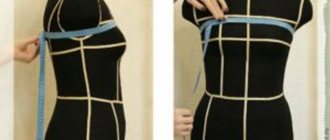DescriptionOrigin
The definition of the word “soft” in the textile world usually refers to entire groups of materials of synthetic or mixed origin, which are distinguished by a soft, pleasant surface. All these materials have a dense texture with short velvety pile, which gives the soft some resemblance to velor.
The composition is most often synthetic or combined, including a combination of artificial fibers and natural ones. The canvas can be plain or with a printed pattern.
To create this type of textile, pure polyester or polyester combined with a small amount of cotton or viscose threads is used. Pure polyester is used to make denser textiles, and combined polyester is used for lightweight materials. Synthetic or blended yarns are woven on a loom in a plain satin or satin weave. After this, the material is dyed in the desired color and dried.
Matter appeared not so long ago - at the end of the 20th century in the USA. Soft fabric was initially produced for upholstering furniture and sewing beautiful curtains, however, over time, this textile began to be used to create beautiful men's and women's suits.
Fabric Features
The material is particularly soft, while the surface of the material is covered with fibers, and can be made with the addition of lycra . This option allows you to sew a dress or home clothes. The fabric is elastic and can hold even the most difficult shape well.
The material looks like velor . It makes wonderful costumes and outfits for both parties and offices.
Soft means “soft” in English. This adjective is often added to different fabrics, for example, soft cotton, soft wool - soft cotton, soft wool. But it also happens that soft is also called a special type of fiber that is particularly soft. They are used to make fabric with a small pile, its second name is artificial velor . Indeed, they feel very similar to the touch.
Jaay - Mobile - Content - 250*360 - 2
Origin story
Natural fabrics were replaced by synthetic ones at the turn of the 20th and 21st centuries. The prerequisite for its appearance was the active introduction of polyester into textile production.
The new type of fabric has become popular due to a number of advantages in softness, practicality, and ease of use.
Work with the material, adding other qualities, improving the composition and expanding its use continues.
Application
The software is used to make bed linen, dresses, children's and home clothes, mattress covers, and curtains . This fabric is also used to make furniture covers, decorative pillows, and bedspreads.
The material has good strength , therefore, depending on its composition, it is very functional both for textiles that require increased strength and for high-quality clothing.
Stretches or not, real review
To finally figure out the question of “whether the software stretches or not,” I decided to go to the store and check the stretchability of the fabric with my own hands. As you can see in the photo, the fabric easily stretches and returns to its original size. The soft stretches quite easily, due to the fact that it contains elastic fibers such as lycra or nylon. It should be noted that the fabric stretches in both longitudinal and transverse directions.
See similar articles
- Batiste is a thin translucent fabric for summer clothing.
- Jacquard - dense fabric with ornaments
- Alpaca is a unique fabric made from long pile wool.
- Nylon is a soft and pleasant elastic synthetic fabric
- Footer - soft cotton fabric for children's clothing
- Fleece is a soft polyester fabric for warm clothing.
If you liked the article, share it with your friends!
Compound
Typically the material contains polyester fibers, but elastic or cotton threads are also found in some samples. Thanks to them, the products are especially durable and at the same time fit well.
Soft fabric is divided into several types:
!— Jaay — Mobile — Content — 250*360 — 3 — >
- Super soft - this type of material is particularly soft, but at the same time has very high strength. This fabric is often used for upholstery or as bedspreads.
- Soft silk is a reversible fabric that is an excellent option for those who are looking for a material that is fleecy and soft on the one hand, and shiny and smooth on the other.
- Soft satin or with the addition of cotton fibers is used for sewing bed linen.
- Stretch soft is used when sewing clothes.
- Blackout fabric is also a special type of soft, used for the manufacture of light-proof curtains.
How to care for a soft dress so that the material lasts for a long time?
Useful recommendations and rules:
- do not wash with items made from other fabrics;
- When washing by machine, prefer to wash by hand if the composition includes viscose;
- steam rather than iron;
- use liquid powders;
- Be sure to use sprays with an antistatic effect.
If steam treatment with the device does not help, place the item on hangers and hang it in a bathtub filled with hot water. There is no strict ban on ironing, you just need to study the composition . Some subtypes of material can be ironed, others require setting a minimum temperature, and wrinkles on others can be removed not with a hot, but with a slightly warm iron.
Simple, high-quality software retains its smoothness after washing; you don’t need to do anything with it. If the dress becomes wrinkled during wear, it will be enough to rub your palm repeatedly to eliminate the problem.
DIY costume of the immortal Koshchei
Running shoes: which spikes are better?
Material properties
The fabric is particularly durable and allows the products to serve for a long time, without deformation or shrinkage.
The main properties of the fabric include:
- drapes beautifully;
- retains its shape;
- easy to cut;
- does not crumble when sewing;
- does not allow sunlight to pass through;
- not picky about care (no drying problems, easy washing);
- the fabric belongs to the hypoallergenic group;
- perfectly insulates from noise;
- resistant to moths;
- does not mold;
- repels dirt;
- does not fade or fade in the sun.
What standards are used in production?
| GOST number | Quality requirements |
| GOST 29298-2005 | Cotton and blended fabrics meet the requirements of: color fastness, shrinkage after washing, tensile strength and abrasion resistance of the fabric; physical and hygienic indicators: air permeability, hygroscopicity, specific surface electrical resistance, free formaldehyde content. |
| GOST 11209-2014 | Fabrics for workwear meet the quality in terms of color fastness, protective properties: water resistance, water repellence, oil and petroleum repellence, loss of strength, acid impermeability, fire resistance; meet the standards after washing, rinsing, spinning, ironing. |
| GOST 29223-91 | Synthetic fabrics for clothing - stable color, sufficient density, meet the standards of shrinkage, pilling, wrinkle resistance, abrasion resistance, breaking load. |
Pros and cons of the material
When choosing this fabric for sewing items for the home or beautiful dresses and suits, you should still take a closer look at its characteristics. Like any other type of fabric, soft needs to follow the care rules.
—>
It is not recommended to wash soft goods at temperatures above +40 degrees. It is advisable to choose the washing mode for ordinary products, excluding too long exposure to aggressive detergents.
This material does not like strong powders, bleaches and rough brushes. You should also avoid drying on hot radiators and excessive stretching.
The advantages of the material include its practicality and excellent resistance to external influences.
Recommendations for use
The final result of using a product made from soft fabrics directly depends on the correct choice of high-quality material, taking into account the characteristics of each type, cutting methods and creating beautiful drapery. Experts give practical recommendations in this direction.
The selection of quality material always begins with a careful examination of the sample in the store. A defective product is considered to be fabric that has lint, sheds in your hands, and has a specific chemical smell. It is not worth buying such material.
Before choosing a material, you should consult with the seller and study the proposed sample
The product is cut equally well in two directions: width and length. Thanks to this, you can save fabric and sew non-standard sized curtains.
The savings are also evident in the fact that only double the length of the material is used to beautifully drape the software.
Types of fabric for stylish dresses
For a dress, you should pay attention to soft material, both plain (with a fuzzy part on the outside and a smooth back side), and fabrics with a pattern.
Jaay - Mobile - Content - 250*360 - 5
There are materials with thermal printing or embossing. To sew dresses, they use super soft, soft silk, soft with the addition of stretch. Everyone who has had to work with this material notes that the products made from it are very impressive. They look great when creating a modern look and complement well with accessories.
Description of external signs
The name soft in English translation means soft and gentle, and fully conveys the impression of the material. Soft fabric is a fabric whose front surface is covered with fine pile, very soft like velor. On the reverse side the software is perfectly smooth. The type of pile will depend on the composition of the fibers: it is glossy, either matte, short and dense, or sparse and long.
The color of the canvas can be in delicate and soft colors, laconic or dark, but in most cases monochromatic. Software with a pattern looks attractive and original. It is applied using thermal printing. The resulting prints are resistant to moisture and ultraviolet radiation and retain the original brightness of the colors for a long time. Fabric with a convex, textured pattern looks advantageous. It seems that flowers, leaves, objects are cut with a low pile. The peculiarity of matter is its ability to form beautiful assemblies and folds. Software often refers to curtain materials.
Care
The fabric tolerates cleaning and care very well and dries very quickly. But you should definitely straighten the product well before drying so that creases do not form on the product made of this fabric.
The purpose for which the software is used is of great importance. If it is for sewing clothes , then you should wash the product in warm water and never use too aggressive detergents.
If the fabric is used
for sewing curtains , then it is worth cleaning them often with a vacuum cleaner. The wet cleaning mode in a vacuum cleaner works well on such fabric .
This once again emphasizes that a product made from software is very easy to care for and has increased practicality.
—>
Software is a modern material. Therefore, it is worth paying great attention to its characteristics related to the quality and structure of the material. If you are looking for a truly unusual fabric that would be especially appropriate for sewing women's clothing, dresses and suits, software will be an excellent solution when choosing fabric.
Jaay - Mobile - Content - 250*360 - 8
Customer Reviews
Buyers respond positively to soft curtain fabric, praising its softness and delicacy. They note that the material looks impressive and neat. A special advantage is ease of care: the material is easy to wash, dries quickly, and does not require ironing. Less popular is software for clothing; despite its beauty and lightness, the stumbling block is the polyester composition: the majority of users are wary of synthetics.
Soft is a popular fashionable fabric, a market leader among curtains and furniture materials. It looks sophisticated and stylish, helping to create an atmosphere of comfort in the interior. It is used less often in sewing outfits, but it emphasizes individuality when creating an image.
What is software
Soft is a separate type of material, although this word is often added to another type of fabric. In this way, the manufacturer wants to convey the softness of the material. Let's take a closer look at what soft fabric is.
The soft material consists of synthetic polyester fibers, but viscose or cotton is often added to them for greater strength and softness. And to make the material elastic, lycra or elastane is added to it.
The canvas has two different sides: the front side - with short thick pile, and the back - matte smooth. Moreover, the front one can also be either shiny or matte. It depends on what fibers were added when making the material. Viscose gives shine, cotton - matte.
At first glance, you might think that this is velvet or velor (due to the presence of pile), but the soft material is significantly different from them. It is much softer, lighter and more pliable in draperies.
Manufacturers dye curtain fabric, soft and not only, mainly in solid, rich colors that can convey all the beauty of the material. When the color is sunny, the fabric shimmers with shine, and its soft texture creates light flowing folds.
Curtains made of velvety soft look very elegant and attractive
The design is applied to the soft material using thermal printing. When in contact with a hot machine, the material heats up and the design is absorbed deep into the fibers, due to which it remains in its original form for a long time.
In order to reduce dust and dirt from settling on the surface of the fabric, it is covered with a nylon layer or treated with special solutions. This gives the software a water-repellent property.
Bright kaleidoscope
The color palette of the software is varied. The material can be presented in plain light or dark panels. Curtain software is often painted in delicate, pastel shades. The furniture imitates various exquisite textures: embossed velvet, velor, plush. Printed fabrics are often chosen for tailoring.
Patterned fabric is made in 2 ways:
- Using thermal printing. This method allows you to get beautiful, clear prints. It also has an additional property - it gives the canvas moisture resistance.
- 3D drawings. The contours of a three-dimensional image are cut from a long pile. This is how texture and realism of the pattern are achieved.
Note: The ornament on the canvas does not fade for many years. It is resistant not only to detergents, but also to ultraviolet radiation. Therefore, even capricious prints applied using 3D technology retain the richness of the shades.
